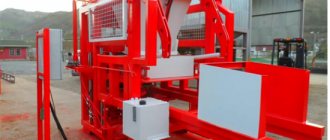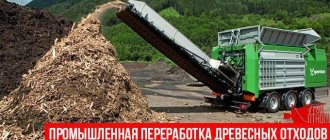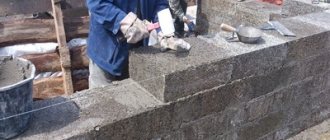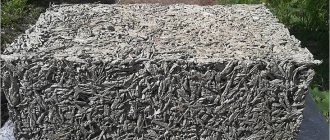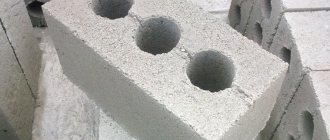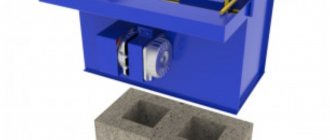The production of wood concrete is a special technology for the production of building materials, which in its properties is close to natural wood. Wood concrete has a low level of thermal conductivity and a fairly affordable cost. Arbolite blocks have a number of positive qualities, the main one of which is their suitability for the construction of walls of any buildings. The production features were popular back in the days of the Soviet Union, then the manufacturing scheme was replaced by other technologies. The popularity of these slabs is returning to the modern construction market.
Equipment for the production of wood concrete allows us to produce an affordable and practical building material that meets the requirements of GOST 54854-2011. Lightweight concretes based on organic fillers of plant origin have many advantages:
- resistance to biological influences;
- the material is vapor permeable;
- good sound insulation;
- wood concrete blocks are fire resistant;
- ease of installation and easy surface treatment.
Compound
The component component of wood concrete is an important stage of production technology, which requires a careful relationship of all components. When making wood blocks, it is important that the quality of the purchased materials is high. Any concrete includes binders, sand, filler (can be light or heavy).
Important! When mixing wood chips, it should be moistened in such a way that excess moisture does not release, and the layer of the needle-like structure itself is covered with a cement composition. During the tamping process, the cement will serve as a connecting link, the outer pores of the blocks will close, thus making the product airtight.
The size of the chips affects the amount of cement that will be used to prepare one cubic meter of wood concrete. When wood chips are made from dry wood, the result is a fine fraction. The needle-like structure requires more cement to be held together. The required volume of materials for the manufacture of one cubic meter of wood concrete:
- 8-10 kg of chemicals;
- 250 kg of cement;
- approximately 200-250 kg of wood chips.
The following materials are added to the chips:
- slaked lime;
- liquid glass solution;
- Portland cement;
- potassium chloride;
- aluminum and calcium sulfate mixture.
Technology
The production of wood concrete blocks is organized both at home and large-scale production is established as a profitable business. To do this, all aspects and stages of production are taken into account and are guided by regulatory documents.
The technology for the production of wood concrete according to GOST must begin with the preparation of the necessary ingredients, of which 85% are wooden components. Wood chips, sawdust, shavings are used. The most suitable types of wood: pine, fir, spruce, poplar, aspen, birch. The presence of bark, leaves and needles is allowed - no more than 5% of the total volume. The blanks are passed through a chipping machine and crushed. The recommended particle size is 5x25 mm. The multi-fraction composition will provide the required density of wood concrete.
The production of wood concrete slabs of large dimensions requires additional reinforcement of the product. A reinforcement cage made of rebar should be placed in a form that is half filled and then filled with wood-concrete composition.
The technology for preparing wood raw materials at home is carried out using various methods - constructing a chip cutter with your own hands or concluding an agreement with a sawmill for the supply of wood waste.
In industrial production, chemical reagents are added to raw materials - calcium chloride, aluminum sulfate, liquid glass. When making at home, it is recommended to keep the wood chips outside for three months, and the sawdust should be stirred periodically. To speed up the process, calcium oxide is added to the embankment - 200 liters of 1.5% solution are used per cubic meter.
Portland cement grade 400 - 600 is suitable as a binder. The mixture consists of 10-15% cement and no more than 1% plasticizers and demineralizers. Before mixing the components, the wood component is poured with a 10% lime solution; it will need to stand for 3 hours. At industrial enterprises, this method of soaking in a technical container takes up to 3 days.
All components are mixed in a concrete mixer. The result will be a homogeneous mass without lumps. The composition of water-chips-cement is 4:3:3. The mixture should have a slightly crumbly consistency and should hold its shape when compressed.
Chip cutter for wood concrete: principle of operation
The main components of the machine are a chipping disk with knives and a rotor with hammers and blades. The disk is mounted on a working shaft, which is driven by a pulley connected by a belt to the engine. The shaft rotates in two roller bearings, and the motor is mounted on a frame.
The supply of raw materials is carried out manually, that is, everything that is to be processed is thrown one at a time into the receiving hopper, and then the wood waste itself is pulled under the working knives and hammers. At the final stage, the chips fall onto the sieve using the blades and fly out of the chip cutter through the unloading hole.
At the entrance, the receiving hopper is made in the form of a funnel in order to simplify the supply of raw materials for processing and make this process safe for hands.
The machine for making wood chips has the following characteristics:
- engine power – 7.5 kW;
- rotation speed on the engine working shaft – 3000 rpm;
- rotation speed of the shaft on which the disk with cutting knives is fixed is 1500 rpm.
When the rotation speed of the shaft with the disk increases, a certain amount of wood raw material may be ground into dust (naturally, this is bad), although the productivity of the wood chipper increases.
The process of obtaining wood blocks
At the molding stage, trays are used to give the products standard dimensions. If it is necessary to make blocks of non-standard dimensions, plates are inserted into the molds, which increase the size and weight of the product. The slab can be triangular or trapezoidal.
To speed up hardening, add a dry calcium chloride mixture to the solution. The solution is poured in layers in three stages into pre-treated molds with lime. Next, the mixture will need to be compacted.
It is recommended to level the upper surface of the blocks with a spatula or rule. Then fill it with plaster mixture to about 20 mm.
When the building material has formed a shape, it is compacted using a wooden device covered with a metal frame. The most durable and reliable building material is one that has withstood and hardened for 10 days at a temperature of +150 degrees Celsius. To prevent the blocks from drying out, they are periodically watered.
Equipment
The necessary units for the production of wood concrete are sold assembled and include all processing and preparation cycles. Advanced technologies make it possible to produce various volumes of building materials with different sizes. To build a machine with your own hands, you will need the following units:
- wood chip cutter, which you can also design yourself;
- concrete mortar mixer or mixing apparatus;
- Press forms;
- vibration machine.
You can produce wood concrete by organizing the production of blocks yourself, and at the same time minimizing the costs of the necessary equipment. A machine for crushing wood chips can also be made by hand using improvised devices. To save money, the vibrating sieve is replaced with a manual sifting method.
It is recommended to replace the unit for producing the working solution with a concrete mixer. The manual mixing method is unacceptable in this method, as there is a risk of lumps and clots forming in the solution.
Forms of the required size are made from ordinary wooden boxes. It is recommended to cover the bottom and sides with linoleum or polyethylene film, this will allow the composition not to stick to the walls.
When the molds are filled according to the technology, the mixture is compacted. To do this, you will need a hammer for tapping the walls of the container and a drill, which is used to make a brick press. They also use a self-made vibrating table. This machine will reduce production time and increase productivity.
If the conditions for drying the material are not suitable, it is recommended to use a drying chamber. This drying method will increase production costs and make the blocks stronger.
Do-it-yourself machine for wood concrete blocks drawing
- Vibropress with a mold fixation mechanism.
- Form with self-sealing function.
- Lifting and rotating hopper with mechanical suspension.
- Winch for bunker control.
- Mixer.
- Winch for lifting dispensers with suspension.
- Trolley with dispenser for wood chips.
- Cement dispenser on a trolley.
- Container for preparing wood preservative.
- The platform is inclined.
- Pallet.
- Rokla.
- Metal construction.
Self-created
To set up a production line for wood concrete blocks, it is not necessary to purchase expensive equipment, but in some cases it cannot be replaced. You can make an alternative with your own hands in the case of a chip cutter, mixer and compactor.
How to make a wood chipper yourself?
To make a wood chip cutter with your own hands, you will need a metal sheet up to 20 mm thick . A circle with a diameter of 300-350 mm is cut out of it. A hole is made inside and a key is inserted. Symmetrical slits are made on the outer perimeter of the circle. For knives I use springs from a car, they are cut into strips of metal, and then sharpened and screwed to the base.
It is also necessary to make a hammer mechanism. For this purpose, metal strips with a thickness of 5 mm are used. They are located on the rotor. A sieve is also prepared: it is made from a round metal container, where a ring is cut off, and then holes are made with a drill. In order to conveniently push chips out of the machine, it is necessary to make crossbars on the back of the disk. As the disc rotates, they will also rotate, thereby pushing the chips out.
Mixer
You can build a concrete mixer for wood concrete with your own hands, thereby not having to spend money on equipment from the factory. To do this you will need a 200 liter barrel, wheels, angles, channels and pipes . You also need fittings, a gearbox, and an electrical wire - it is better to make an electric concrete mixer than a mechanical one.
If you take an old-style washing machine, you can use the electric motor from it. You also need bearings and a large amount of fasteners: screws, bolts and nuts.
Note ! You need to prepare tools: a hacksaw, welding machine, grinder, drill, pliers and a set of keys.
First, a welded frame is made, then containers for mixing the solution are assembled. Next, install the electric drive and gearbox, and connect the wiring to them. At the final stage, it is necessary to check all equipment for its serviceability and safety.
Sealant
The seal design consists of several elements:
- table top;
- vibration device;
- table;
- compaction device.
First, the table is made: it consists of legs that are welded to the frame. The frame is made rectangular, its dimensions are 50x70 cm. The length of the legs is adjusted to suit your preferences. The tabletop must have cross braces, as it will be subject to serious loads. It must match the frame format.
The compactor requires a powerful motor; it is recommended to take a product of type VI99/E - it can adjust the oscillation frequency.
DIY production
The technology for making wood concrete yourself is not complicated if you have the necessary tools and devices. If you follow all the rules and manufacturing criteria and correctly calculate the components, the product will have high quality and strength.
Materials and accessories:
- Special container for components.
- Vibrating table.
- Surface with shock-shaking functions.
- Metal pallets.
- In order to obtain a high-quality solution, you need a concrete mixer. If you mix it yourself, it will take a lot of time and effort to obtain a solution of the desired consistency.
- Special plastic molds of the required sizes. Arbolite blocks have a rectangular shape, standard sizes are 500x189x300 mm and 500x188x200 mm.
- A special machine will professionally chop the wood chips.
- Using a press, a high density of material is obtained. During the compaction process, air is removed from the material as much as possible.
- The drying chamber for wood concrete blocks turns the structure into a solid one-component material.
- Shovels to load the mixture into molds.
- Reinforcing mesh is used to fasten wood blocks.
With such devices, on average, from 400 to 500 cubic meters of building mixture are produced per month. The recommended minimum size of the production premises is 500 m2. Electricity consumption will be 15-45 kWh. During preparatory work, organic components are poured with liquid cement until a homogeneous mass is formed. Observing the proportions and calculations, the resulting mixture should be free-flowing.
Bunkers and molds have a standard size of 20x40x60 cm; they can be welded or made from cut sheets of metal. It is recommended to place the blocks vertically during manufacturing; this will simplify compaction with a small press area.
Design options for homemade wood chippers
Typically, two design options are used for DIY manufacturing:
- Double-roll wood chipper . Users are attracted by the ease of creating cutting tools - circular saws or wood cutters are used. mounted on two parallel rotating shafts. It is not difficult to transmit rotation to them, finding the required number of cutters is also not a significant problem. All that remains is to make the frame and weld the machine casing.
- Disk type . Here, knives from an electric planer are used, mounted on a rotating disk. The working element itself requires good balancing, otherwise the machine will quickly fail due to strong vibration. Usually the disc is ordered from a turner, and they only mount the knives themselves and make a protective casing with supply and ejection diffusers.
Both types of machines are manufactured using different tools:
- Grinder with cutting disc.
- Welding inverter with a set of electrodes.
- Drilling machine.
- Set of wrenches.
- A set of common plumbing tools (hammer, pliers, screwdrivers, etc.).
Expert opinion
Levin Dmitry Konstantinovich
During the work process, you may need other tools available to the user. The final choice is determined by the design chosen as the basis for the future machine.
All work is carried out in stages:
- Making a frame from a channel or a strong corner.
- Installing the hubs of the working body and checking the functionality of the shaft (or shafts).
- Installation of drive pulleys and tensioning mechanism, adjustment of correct movement when tensioning drive belts.
- Cutting metal sheets for making a body. They are attached to the frame with threaded connections.
- Manufacturing and connection of chip supply and ejection diffusers.
The manufacturing stages are indicated conditionally; additional operations are possible during assembly.
Reviews and recommendations from experts for independent production of blocks
Experts and private builders who practice making wood concrete blocks leave reviews advising them to follow the rules to help achieve high quality products.
- In production technology, it is recommended to use not only large chips, but also sawdust and wood shavings.
- The consistency of the wood is processed in such a way that the sugar is removed from it. The technique will prevent further swelling of the finished material, which is strictly unacceptable in the construction of houses.
- During the manufacturing process, the mortar must be thoroughly mixed and ensure that all parts are in the cement mortar. This point is important for high-quality and durable bonding of wood and other materials in blocks.
- During manufacturing, it is important to add aluminum, slaked lime and other components. For example, liquid glass added to the composition will not allow the finished building material to absorb moisture, and slaked lime has antiseptic properties.
- Potassium chloride will not allow microorganisms and other substances that adversely affect the material to form in the structure.
- When mixing components, it is recommended to monitor proportionality so that the prepared mixture meets the requirements for the production of wood concrete blocks.
Methods for forming arbolite blocks
We have already written about the composition and proportions of the mixture for the production of wood concrete blocks in the first part of this article. Today we will talk about how to properly form and compact the wood concrete mixture, as well as the rules for storing finished blocks.
Currently, there are several ways to form an arbolite mixture:
- Manual compaction on the floor of a production room.
- Manual compaction using a vibrating machine.
- Mechanized compaction using vibrocompression method.
- Forming on a vibrating machine with a weight.
Which one is more preferable depends on the planned production volume.
Let's consider the listed methods in more detail.
Manual compaction on the floor
The presented method is considered the most economical. As a rule, it is used when it is necessary to produce material for building your own house, but sometimes this method is used when opening a new production.
a991enUser FORUMHOUSE
If you don’t have a lot of money, I would start with manual tamping (without a machine at all), that is: a hand tamper plus a vibrating platform or just a hand tamper. With a volume of 100-120 m³ per month, this is an excellent option.
The presented method assumes the following equipment:
- a forced-type mixer or a container for manually mixing the mixture (some use conventional concrete mixers, but their use in practice is not always effective);
- steel forms for blocks;
- manual rammer (steel);
- a flat base on which the forms will be installed (the base is covered with plastic film);
- pallets for storing finished products.
Immediately after mixing, the wood concrete mixture is laid out in molds. Molding is carried out in 2-3 stages: the mixture is placed into molds in layers, and each layer must be compacted sequentially. Before compacting, the mixture should be pierced using a narrow fork.
Whatever molding method you choose, special attention must be paid to the design of the molds themselves. Thus, the size of the form in length and width corresponds to the size of the blocks. The height of the form is always greater than the specified size. This is done so that the required volume of uncompacted mixture can fit into the mold. The compaction coefficient varies within the following limits: from 1.2 to 1.6. Moreover, it will correspond to the average density of structural wood concrete (700 kg/m³). In other words, if your block height is 37 cm, then the minimum height of the form should be 44.5 cm. The form is filled to the top edge, and then the mixture is compacted to the height of the block (the higher the form, the higher the density of the finished blocks and, accordingly, , their strength is higher).
The blocks can be immediately made universal so that their dimensions can simultaneously be suitable for the construction of walls (37 cm thick) and for the construction of partitions (16 cm thick).
ecodrevFORUMHOUSE user
Size –50x37x16. Thanks to all the forum members, this is exactly the size we are making. This block will be universal - wall and partition.
The thickness of the arbolite wall, protected from moisture (insulated), should be 30 cm. If there is no protection - 37 cm.
Molds for wood concrete should be made either of steel (stainless steel) or wood (with stainless steel lining). The body of the mold should consist of two parts, and such a design will have no bottom.
Both halves are connected using metal pins.
Instead of a bottom, a plywood board or a flat base of a concrete floor is used. The surface of the base should be covered with plastic film. This is done in order to protect the base from sticking of the mixture. In this case, linoleum or special solutions can be used to protect the side and bottom surfaces of the mold from adhesion of wood concrete. And here is the protection option used by one of our portal users.
ChombaFORUMHOUSE user
For a long time they played tricks with various “chemistry” intended for lubricating metal forms. As a result, we took used vegetable oil from the food industry (our price is 650 rubles for 50 liters) and tried it. This is the second year we've been using it exclusively. Works great.
It is advisable to equip the walls of wood concrete forms with special fasteners (latches).
Activated during compaction of the mixture, they fix the tamping cover in a position corresponding to the height of the block.
The lid is hammered in using a steel tamper, which was used to sequentially compact several layers of wood concrete mixture.
The manual molding method uses several molds. Each of them is designed for 1 or 2 blocks. This method allows for the demoulding of finished products both instantly (immediately after molding) and after a certain time (10-12 hours after molding). The second option allows you to obtain more durable products.
It is advisable to transfer blocks to pallets 2-3 days after formwork. It is possible to stack blocks on top of each other only 3-4 days after their manufacture, and to store products in three rows (in height) only 6-7 days after stripping.
Despite the difference in the density of blocks obtained by manual compaction, if the technology is followed, their strength will always meet construction standards.
Manual compaction on a vibrating table
This molding method involves the use of all those devices that are listed in the previous chapter. The only thing you will have to purchase additionally is the vibrating table itself.
During the process of forming blocks, wood concrete forms (together with a base covered with polyethylene) are installed on the surface of a vibrating table. Then the mold is filled with the mixture, which is immediately pierced with a thin fork. At the next stage, a vibrating machine is used. The device turns on for a short period of time: 10-30 seconds. The exact operating time of the machine is determined experimentally.
After turning off the machine, the mixture is compacted using a manual tamper and a locking lid. The formed blocks together with the base can be removed from the surface of the vibrating table.
The vibration time of the wood concrete mixture is one of the decisive factors that determines the quality of the finished blocks. Prolonged vibration leads to deterioration in product quality.
You can strip the formwork immediately, or you can do it 10-12 hours after molding.
The advantages of forming on a vibrating table are the possibility of obtaining blocks with a more uniform internal structure. At the same time, the density of blocks made in the process of several batches will differ slightly (which cannot be said about the quality of products obtained by conventional manual tamping).
Molding on a vibropressing machine
Forming blocks using a vibrating machine requires the presence of main and auxiliary equipment:
- container for diluting chemicals. additives;
- measuring containers for filling cement and filler;
- vibrating machine with steel molds;
- carts for transporting wood concrete mixture (if necessary);
- wooden or steel pallets for forming (can be designed for several blocks at once);
- racks and pallets for storing blocks.
The presented molding method requires the purchase of a special vibrating machine, which has a rather complex design (it is very difficult to make such a machine yourself, and commercially available equipment often requires modification).
a991ru
A huge number of different vibrating machines are sold on the market, but, unfortunately, without making changes, almost none of them are suitable for the production of wood concrete.
Changes should affect the design of the vibrating platform and pressing mechanism. So, instead of a vibrating platform, it is necessary to install a vibration-impact installation (so that the cement does not flow off the surface of the chips during vibration).
VIKTOR 220FORUMHOUSE user
It is not advisable to make blocks on a vibrating table, since the cement laitance tends downward. Arbolite requires shock shaking.
If during manual molding on a vibrating table a similar problem is solved by preliminary bayoneting, then the design of the vibrating machine does not provide for this operation. In addition, if the pressing mechanism is driven by hydraulic (or pneumatic) cylinders, it will very quickly fail under the influence of strong vibration. The wood concrete manufacturer has to solve all these problems independently.
Some manufacturers use a screw press option.
Ecodrev
I have already produced more than 10,000 m3 on a screw press (in 3 years). No problems noticed. We only change the chain 2 times a year, the engine - 1 time every 1.5 years, and promptly replace the bronze washers (once a year). I think that if the press is made correctly, it is a workable option.
Each manufacturer chooses the design of a concrete blocking press independently.
Forming sequence:
- The forms are filled with wood concrete mixture.
- The mixture is exposed to a vibration-impact installation (for 10-15 s).
- The mixture is pressed (pressing is carried out either during operation of the vibration-impact mechanism or after it is turned off).
- The pallet with the finished blocks is transferred to the rack.
The blocks can be stacked one on top of the other, just as in the two previous cases, no earlier than 3-4 days after production. Items can be stored in several rows (in height) only after a week.
Drying of blocks, in most cases, occurs at natural (positive) temperatures. As a rule, additional heat treatment is not required for products.
The advantages of making blocks on a brick press are the maximum mechanization of labor and the ability to produce blocks with a uniform structure.
Vibration with weight
Now let's move on to a description of the most common method of forming blocks, which allows you to mechanize the technological process and at the same time optimize the costs associated with starting production.
A vibrating machine with a weight can currently be purchased on the market, and if you have the appropriate drawings, you can make it yourself (or order production at a specialized manufacturing enterprise).
Compact wood concrete machines with a weight are most often designed for molding only one block at a time, so the weight can be easily lowered into the mold by hand.
A list of equipment for the production of wood concrete using the specified method is presented in the previous chapter. Only the vibrating pressing machine, in this case, is changed to a vibrating machine with a weight. If you organize timely switching on and off of the vibration installation, then the presented molding method will make it possible to obtain strong and reliable blocks, while instant formwork does not in any way impair the quality of the finished products.
Forming sequence:
- After filling the form, the vibration installation is switched on (if the form is filled by mechanization, then the vibration can be turned on during the process of pouring the mixture). The duration of vibration is several seconds and is determined experimentally.
- At the next stage, the weight cover is lowered into the mold. Further vibration is turned on either simultaneously with pressing, or after the weight is lowered into the mold (it all depends on the design features of the machine).
- After the load is lowered into the mold, the vibration starts (or continues) without fail.
AnuganForumHouse user
For everyone, in simple terms: you need to turn on the vibration as the mixture is poured into the mold, but in order not to overload the mechanisms and not separate the mixture, the vibration strength must be regulated (by a frequency control, for example). Low frequency - during the filling process, high frequency - at the moment of applying the top weight plate to the mixture. This is exactly what I do.
The method of cyclic loading has proven itself quite well: during the process of molding the block, the loading weight is raised and lowered into the mold several times.
a991ru
Usually 3 cycles of lifting and lowering the load are sufficient. In this situation, after instant unpacking, there is practically no internal pressure or redification in the block.
The total time of vibration of the mixture, as for previous molding methods, should be 10-15 s. After pressing, the blocks are stripped. You can stack the blocks on top of each other no earlier than 3-4 days after unpacking.
Now let's talk about the weight of the load. To create a compaction coefficient (Cup) of 1.27 for an arbolite block, a force of 0.01 MPa (or 0.1 kg/cm²) must be applied to its surface. In order for Kop to be equal to - 1.34, the applied force must be 0.02 MPa (or 0.2 kg/cm²). These indicators are achieved by simultaneous vibration and pressing of the mixture. By applying such forces to the surface of the block, it is possible to obtain products with structural strength. And knowing the dimensions of the block, you can quickly calculate the required weight of the load.
For example, a 50x37x16 block has a surface area of 1850 cm². In order for the compaction coefficient of such a block to be 1.34, the weight of the additional load must be equal to 1850 x 0.2 = 370 kg. If you focus on Kup - 1.27, then the weight you need is 185 kg.
AnuganForumHouse user
I intuitively chose the most effective production method for a mold of 6 blocks: vibration with a load under pressure - 0.1 kg*s/cm2. Different vibration frequencies and directional vibration are used.
The effectiveness of molding with a weight has been repeatedly confirmed in practice and is very popular among modern wood concrete manufacturers. As we have already said, the simplest machine designed for molding one block can be made independently. Schematically the device looks like this:
Its main elements are listed in the table.
The process of its manufacture requires precision, certain knowledge and skills. If you want to try your hand at this, you can find detailed drawings on the Internet in accordance with which the machine is manufactured.
We bring to your attention a photo of a homemade machine.
Mixer design
Now let’s talk a little about the forced-type mixers that members of our portal use when mixing wood concrete mixtures. A forced-type mixer, unlike a conventional concrete mixer, is optimally suited for mixing wood concrete.
This is explained by the fact that light wood chips do not mix well in a mixer for heavy concrete mixtures.
Kostyan microdistrict 1FORUMHOUSE user
The use of just such mixers is explained by the fact that the raw materials being mixed are light in weight, so the use of gravity mortar mixers to create a mixture is not entirely advisable.
A forced mixer consists of a frame, a motor, a gearbox, a working container and a working shaft with blades. The mixer, like the machine, can be purchased on the market, or you can make it yourself.
Here, for example, is the design proposed by a user of our portal.
SHERLOCK HOLMESFORUMHOUSE User
Three blades drive the mixture to the left, then three blades drive the mixture to the right. Steel blades made of 12 mm sheets with rubber linings with cord (from truck tires) will be screwed onto the shaft. Engine power – 5.5 kW.
The calculated speed of the mixer working shaft in this case corresponds approximately to 40 rpm.
As we have already said, at the initial stages of production a minimum of equipment and materials will be required. You can think about purchasing and manufacturing production equipment if there is a need to increase production volumes.
What kind of equipment is needed for the production of wood concrete blocks? What performance should it have? How to properly use the workspace of the room? Everyone will answer the above questions in their own way. A clear understanding of the picture comes after the technology has been developed to guarantee the production of high-quality and durable blocks.
Checking the strength of blocks
Strength testing of arbolite blocks should be carried out only after the products have completely dried, that is, they have reached their constant weight (this requires approximately 20 days). The density of wood concrete can be most accurately determined only in laboratory conditions. In accordance with SN 549-82, samples with dimensions of 150x150x150 mm are tested.
To dry the wood concrete to a constant weight, it should be stored in a room with a stable air humidity. You can also dry it outside (under a canopy).
Strength indicators are determined by two main parameters: axial compression resistance (prismatic strength) - Rbk, and axial tensile strength - Rbtk. The minimum strength of structural wood concrete is 21 kgf/cm².
EcoblocksuForumHouse User
To build a one-story house with an attic or a two-story house, it is necessary to use structural wood concrete with a minimum strength grade of M25, which corresponds to the strength class of B1.5 (the minimum compressive strength is approximately 21 kgf/cm2).
Frequently contacting the laboratory to check strength is expensive. Yes, and this will take a lot of time. Here's a way to test strength that one of the users of our portal came up with: he connected a pressure gauge to a regular hydraulic jack and installed the device in a homemade test setup.
tyjdnfhmjFORUMHOUSE user
Upper platform – 150 mm. The diameter of the jack piston is 35 mm. The pressure gauge came from a high-pressure oxygen reducer - convenient. You take readings without zero. For example, 150 is equal to 15 kg/cm².
The strength of a block is recorded at the moment its destruction begins (when the first cracks appear). With a gradual increase in load, this method allows you to accurately determine the characteristics of the product.
In order for experiments on the production of wood concrete blocks to take place with maximum efficiency, we recommend visiting the section dedicated to discussing the technological features of the production process. The topic dedicated to production equipment will help you find answers to questions regarding mechanized devices for the production of wood concrete. A video dedicated to the construction of walls from arbolite blocks will teach you how to properly handle the presented material.

